
Tech for Good: Innovations Addressing Global Social Challenges
Share
In an increasingly interconnected world, technology has emerged as a powerful tool to tackle pressing global challenges. From improving access to education and healthcare to addressing climate change and promoting social equality, technological innovations are proving to be transformative in creating a better and more equitable future. This article explores some of the key areas where technology is driving meaningful change and the challenges that lie ahead.
Bridging the Digital Divide
One of the foremost challenges of the modern era is the digital divide—the gap between those with access to technology and those without. Addressing this disparity is critical to ensuring equal opportunities in education, employment, and access to information.
- Affordable Internet Access: Companies like SpaceX with its Starlink project are deploying low-orbit satellites to bring affordable internet to remote areas. Similarly, initiatives such as Google’s Project Loon aim to use high-altitude balloons to provide connectivity to underserved regions.
- Low-Cost Devices: Organizations like One Laptop Per Child (OLPC) are creating affordable, durable, and energy-efficient devices tailored for students in low-income countries.
- Digital Literacy Programs: Nonprofits and governments are investing in digital literacy programs to ensure people can effectively use technology to improve their lives.
Healthcare Innovations
Technology is making healthcare more accessible, efficient, and patient-centered, particularly in underserved regions.
- Telemedicine: Platforms like Babylon Health and Teladoc Health allow patients to consult with doctors remotely, reducing the need for physical visits and increasing access to healthcare professionals in rural areas.
- AI for Diagnostics: Artificial intelligence is revolutionizing diagnostics. AI-powered tools can analyze medical images to detect conditions such as cancer or eye diseases with high accuracy, even in resource-limited settings.
- Portable Medical Devices: Innovations such as handheld ultrasound devices and smartphone-based diagnostic tools enable healthcare workers to deliver care in remote locations.
- Vaccine Distribution: Blockchain and IoT technologies are being used to monitor the distribution of vaccines, ensuring transparency and reducing wastage.
Education and Skills Development
Education technology (EdTech) is transforming how knowledge is disseminated, making learning more inclusive and adaptable.
- Online Learning Platforms: Platforms like Khan Academy, Coursera, and edX provide free or affordable access to world-class education for millions worldwide.
- Gamified Learning: Apps such as Duolingo and Prodigy are making learning engaging through gamification, particularly benefiting children in under-resourced schools.
- Virtual Reality in Education: VR is being used to create immersive learning experiences, such as virtual science labs or history tours, that enhance understanding and retention.
Tackling Climate Change
Technology plays a pivotal role in combating climate change and promoting environmental sustainability.
- Renewable Energy Innovations: Advances in solar panels, wind turbines, and battery storage systems are making renewable energy more affordable and accessible.
- Smart Agriculture: IoT devices and AI-powered tools help farmers optimize water usage, reduce waste, and increase crop yields, promoting sustainable farming practices.
- Carbon Capture and Storage: Technologies like Climeworks are working on capturing carbon dioxide directly from the atmosphere, helping to offset emissions.
- Waste Management: AI-driven waste sorting and recycling systems are improving waste management efficiency in cities worldwide.
Social Equality and Inclusion
Technology is fostering inclusivity and empowering marginalized communities.
- Assistive Technologies: Innovations like speech-to-text software, smart prosthetics, and screen readers are enhancing accessibility for individuals with disabilities.
- Blockchain for Transparency: Blockchain is being used to ensure fair wages and reduce corruption in supply chains, particularly benefiting workers in developing countries.
- Microfinance Platforms: FinTech solutions like Kiva connect small-scale entrepreneurs in underserved areas with microloans, fostering economic growth and reducing poverty.
Disaster Response and Humanitarian Aid
Technology is revolutionizing how relief efforts are coordinated during crises.
- Drones for Delivery: Drones are being used to deliver medical supplies, food, and disaster relief materials to areas that are otherwise difficult to access.
- AI for Disaster Prediction: Predictive analytics and AI algorithms help forecast natural disasters such as floods, hurricanes, and earthquakes, enabling better preparedness.
- Blockchain for Aid Distribution: Blockchain ensures transparent and efficient distribution of humanitarian aid, minimizing corruption and ensuring resources reach those in need.
Challenges and Ethical Considerations
While technology offers immense potential, it also presents challenges that must be addressed to maximize its impact:
- Data Privacy: Ensuring data security and protecting individual privacy are critical as tech solutions often involve collecting sensitive information.
- Accessibility: Despite progress, many communities still lack the infrastructure to benefit from technological advancements.
- Ethical Use of AI: AI algorithms must be designed to avoid biases that could exacerbate existing inequalities.
- Environmental Impact: While tech can mitigate climate change, the production and disposal of electronic devices contribute to e-waste and emissions.
The Way Forward
To truly leverage technology for good, collaboration between governments, private sectors, and non-profits is essential. Investments in infrastructure, policy frameworks to ensure ethical use, and initiatives to promote digital literacy will play a crucial role in expanding the reach and impact of tech-driven solutions.
Conclusion
Technology has the power to address some of the world's most pressing challenges, from bridging the digital divide to combating climate change and improving healthcare. By fostering innovation and ensuring equitable access, we can harness the potential of tech for good, creating a more inclusive and sustainable future for all.
